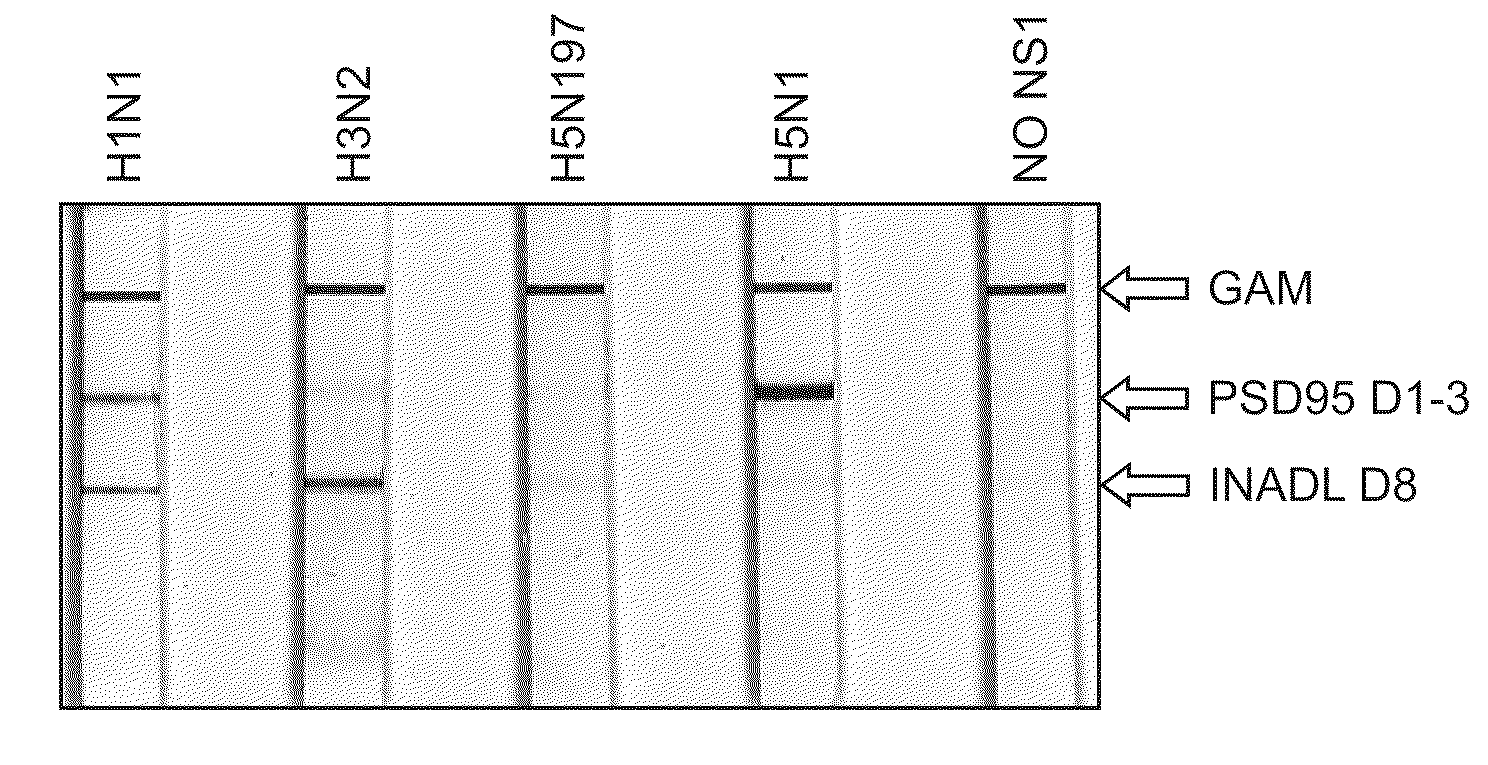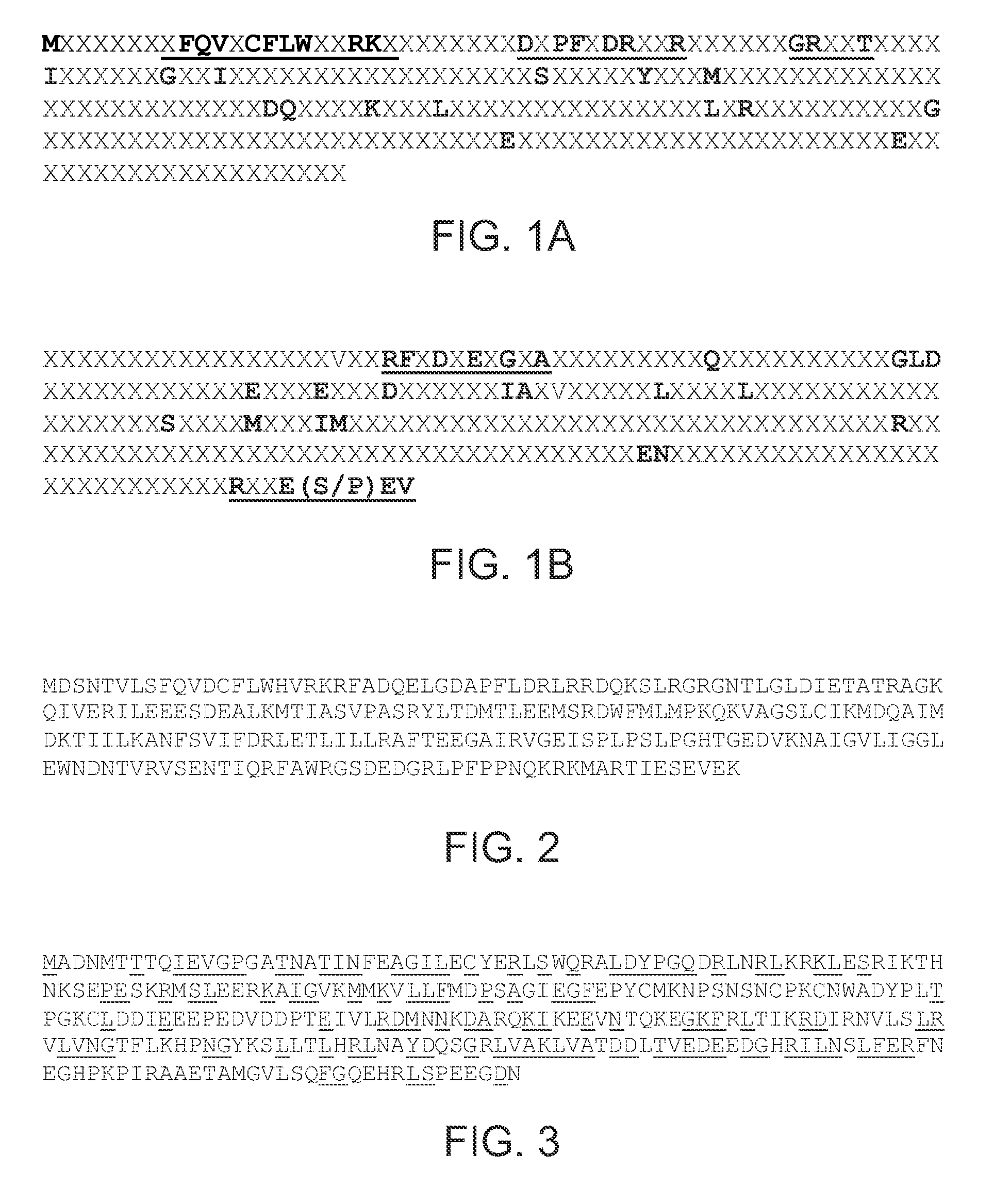Detection of influenza virus
a technology of influenza virus and detection method, applied in the field of detection of influenza virus, can solve the problems of local outbreaks of flu, limited use of flu vaccines, and high training requirements, and achieve the effect of reducing the difficulty of on-site or field testing
- Summary
- Abstract
- Description
- Claims
- Application Information
AI Technical Summary
Benefits of technology
Problems solved by technology
Method used
Image
Examples
example 1
NS1 Protein is Expressed in Human Clinical Specimens
[0089]Human nasal secretions were examined for the presence and amount of NS1 from Influenza A. Human nasal aspirates were collected and stored in M4 viral transport media (Remel, Inc, Lenexa, Kans.) at −80° C. Stored material was thawed and run on 10% SDS-PAGE. Western blot analysis was performed with monoclonal antibodies to NS1, 3H3 and 1A10 (Arbor Vita Corporation, Sunnyvale, Calif.). The results for six samples are shown in FIG. 4. The results show that NS1 is present in large amounts in nasal secretions.
[0090]To investigate the timeline of when NS1 was produced and secreted by cells infected with influenza A virus, MDCK cells were infected with human influenza A / PR / 8 at a MOI of 0.1. Supernatant as well as cells were collected and lysed in 1% TRITON® X-100 and subjected to SDS-PAGE and western analysis with monoclonal antibody 3H3 which is pan-reactive to NS1. NS1 was detected in infected cells within 24 hours after infection...
example 2
NS1 Interacts with PDZ in Cells
[0091]To verify that NS1 interacts with PDZ proteins in cells, a series of PDZ pull-down experiments were performed. 293 HEK cells were transfected with plasmids containing HA-NS1-H5N1B or with HA-NS1-H3N2. Lysates were prepared as described herein. Glutathione-SEPHAROSE -PDZ beads were prepared (10 ug of DLG1d1,2 10 ug of NeDLGd1,2, and 10 ug PSD95d1,2,3) and used to pulldown 150 ug of lysate from transfected 293ET cells as shown in FIGS. 6 and 7. Following an overnight incubation at 4° C. and multiple washes with HNTG buffer, a membrane was prepared with the pulldowns. The membrane was probed with F63-3G1 supernatant (1:5). All 3 of the PDZs tested successfully pulldown NS1 from cell expressing HA-H5N1B (see FIG. 6).
[0092]Similarly, glutathione-SEPHAROSE-PDZ beads were prepared (40 ug of INADLd8) and used to pulldown 150 ug of lysate from 293ET cells transfected with H3N2. Following an overnight incubation at 4° C. and multiple washes with PBS, a wes...
example 3
Monoclonal Antibodies to NS1
[0094]Monoclonal antibodies were prepared to specifically bind to subtype NS1 proteins (e.g., H5N1), NS1 PL classes (e.g., ESEV) and for pan-specificity (influenza A). The strategy for the generation of monoclonal antibodies to NS1 is as follows:[0095]1. GST and MBP fusion proteins of NS1 were generated. The cloning vectors were obtained from Pharmacia (GST) or New England Biolabs (MBP). The NS1 coding regions were synthesized using overlapping oligonucleotides by DNA 2.0 (Menlo Park, Calif.).[0096]2. Mice were immunized with MBP-NS1 fusion proteins at doses ranging from 10-100 ug per dose in CFA then IFA and PBS.[0097]3. Splenocytes and lymphocytes were harvested 3 days after the last boost with the corresponding GST-NS1 fusion protein and fused with FOX-NY myeloma cells according to Kohler and Milstein (Nature 1975).[0098]4. The hybridomas were screened first with MBP-NS1 in an ELISA. The positive wells were cloned and rescreened with a panel of MBP and...
PUM
| Property | Measurement | Unit |
|---|---|---|
| dissociation constant | aaaaa | aaaaa |
| dissociation constants | aaaaa | aaaaa |
| concentration | aaaaa | aaaaa |
Abstract
Description
Claims
Application Information
 Login to View More
Login to View More - R&D
- Intellectual Property
- Life Sciences
- Materials
- Tech Scout
- Unparalleled Data Quality
- Higher Quality Content
- 60% Fewer Hallucinations
Browse by: Latest US Patents, China's latest patents, Technical Efficacy Thesaurus, Application Domain, Technology Topic, Popular Technical Reports.
© 2025 PatSnap. All rights reserved.Legal|Privacy policy|Modern Slavery Act Transparency Statement|Sitemap|About US| Contact US: help@patsnap.com



